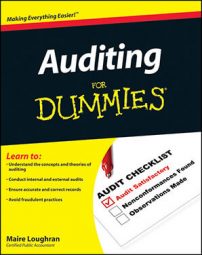Your first task when reviewing your audit client’s stockholder equity transactions is to double-check the terms of the corporate charter. The corporate charter contains pertinent facts about the corporation such as its name, address, and information about the type and number of stock shares it’s authorized to issue. The term articles of incorporation refers to the same document. The person in charge of forming the corporation (or an attorney hired to do the task) prepares this document.
After it’s prepared and approved by the corporation’s originators, the corporate charter is filed with the Department of State in the state that the corporation is located.
If you’re working on a continuing audit client, the charter should already be in the client’s permanent file. If not, you’re responsible for asking the client for a copy of the corporate charter.
So what exactly are you looking for that relates to stockholder equity? You want to make sure that the terms contained within the corporate charter match the financial statements. The charter always has a section (or article) that sets the limit for the number of shares that can be authorized. Other important facts about stockholder equity are the number of shares of stock issued and outstanding:
Authorized shares: This term refers to the maximum number of shares a company can issue. Shareholder approval is normally required when a company wants to increase the number of shares authorized, so most corporations set an extremely high number of authorized shares from the very beginning.
Issued shares: When a company sells stock to an investor and receives cash or some other benefit in return, it has issued shares to that investor.
Outstanding shares: After stock is issued, it’s classified as outstanding for as long as it’s in the hands of the investors instead of the company.
Here’s an example of an audit task to perform: If the corporate charter allows only common stock to be issued, make sure no preferred stock is showing in the paid-in capital section of the balance sheet. Unless the company uses an independent registrar, proper controls dictate that an officer of the corporation (its president, vice president, secretary, or treasurer) is in charge of making sure that all stock and dividend transactions are in line with the corporate charter.
Larger companies usually outsource the handling of stockholders’ equity transactions to various registrars and agents. If your client does so, lucky you! Outsourcing serves to strengthen internal controls because it represents independent oversight of the stockholder transactions. Outsourcing also increases your audit’s efficiency because you can probably get most of your evidence to support the client’s stockholders’ equity assertions from confirmations sent to the registrars and agents. Confirmations are written responses from independent parties that do business with your audit client. The purpose of confirmations is to verify information on the financial statements.

